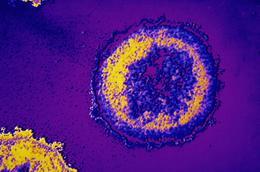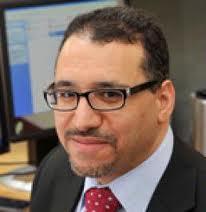The Missing Kingdom: Why Fungi Must Be Central to Conservation Strategy
28 December 2025
Published online 2 August 2011

HIV is already a concentrated epidemic within the community of men who have sex with men (MSM) in several Arab states, infecting more than 5% of them in Egypt, Sudan and Tunisia, warns a new report.
The paper, published in the journal PLoS Medicine, is the first systematic review of the rate of HIV/AIDS within the MSM community in the Middle East and North Africa (MENA) region. Both HIV/AIDS and same-sex relationships are taboo subjects in the Arab world that are hardly addressed, which has left a virtual gap in the scientific literature about the region.
Ghina Mumtaz, a senior epidemiologist at Weill Cornell Medical College in Qatar (WCMC-Q), and the lead author of the paper, challenges that this is a widespread misconception. "In a region that is often thought of as the black hole in the global HIV map, there is considerable and growing body of evidence about HIV and MSM.
"This common mistaken-belief that there are no meaningful data about HIV in the region created an intense debate as to the status of the epidemic and the role of the conservative socio-cultural context in shaping the epidemic in MENA."
I have been living with HIV for three years now. If there was someone who had given me information in the past, maybe things would have been different today.
According to the study, the prevalence of HIV infection among MSM in the Arab world has been low in the past. Since 2003, however, there has been an increasing trend in prevalence among the stigmatized MSM community. "The Middle East and North Africa can no longer be seen as a region immune to the HIV epidemic," adds Mumtaz.
The study found that Egypt is the only Arab country that has already conducted two rounds of HIV surveillance, with a third one planned in the future. The prevalence of HIV/AIDS in a 789 men sample of the MSM community in Cairo, Alexandria and Luxor is 5.8%.
"I expected higher numbers, but at least the 2010 study has shown a lower percentage of prevalence compared to the one done in 2006," said Magid Rabiea, who is a person living with HIV/AIDS from the MSM community in Egypt.
Sudan and Tunisia were the two other countries with concentrated epidemics in MSM communities, with a prevalence level of 7.8% and 4.9%, respectively.
Jordan and Lebanon have lower rates of prevalence at 0.2% and 3.7%, respectively. "The methodology of these studies was sound. However, these numbers should be interpreted carefully as they are from only one such study in each of these countries. The status of the epidemic in these countries would better be assessed after at least two rounds of surveillance are completed," says Mumtaz.
Other Arab states, such as Algeria, Djibouti, Libya, Somalia, the Gulf countries, and the Palestinian Occupied Territories did not have any recent prevalence studies for the team from WCMC-Q to work with, so details of the status of the HIV/AIDS epidemic remains very limited there. "Some other countries, such as Syria and Yemen, have some relatively recent HIV prevalence measures from HIV testing data indicating zero prevalence. However the quality and representativeness of these point-prevalence measures remains limited."
While some of the studies that Mumtaz and her colleagues assessed were published in international, peer-reviewed journals, many were conducted locally and supported by the individual MENA governments whose findings were never publicly published.

According to the report, approximately 2–3% of men engage in sexual relations with other men in the MENA region. This rate is comparable to other regions of the world. Many of them are involved in HIV-related risk behaviours, such as low rates of condom use, multiple sex partners and injecting drugs. They are also sometimes involved in commercial sex networks.
In most MENA countries, the rate of condom use among MSM was generally below 25%, with the only exceptions being Lebanon and Oman. The lowest rate was found in Egypt. General knowledge of condoms was relatively high — but knowledge of their protective effects much lower.
"The problem was never about cheap access to condoms," says Rabiea. "But most MSM refuse to use them because they feel they reduce the pleasure. Many others are embarrassed to go to a pharmacy or a non-governmental organization [NGOs] to buy them."
Over 90% of most MSM populations surveyed in the region reported having multiple sex partners, often concurrently. This ranges from an average of 4 to 14 partners per man in the last six months. This can increase exponentially for those involved in commercial sex.
There is a large body of evidence that points to an overlap of risk behaviour between MSM and injecting drug users (IDU), says Laith Abu-Raddad, an assistant professor of public health at WCMC-Q and the principal investigator on the study. Over 11% of MSM in Egypt, and 15% of those in Tunisia, have reported injecting drugs as well. "This overlap between MSM and IDUs is one of the factors contributing to HIV epidemics among MSM in the region."
If we continue burying our heads in the sands and ignoring these marginalized communities the epidemic will explode from a concentrated population to the general population.
As the MSM community is persecuted across the Arab world owing to cultural and religious attitudes, it is often difficult for health ministries in MENA to treat MSM. "Within the present socio-cultural and legal climate, countries in the region have to come up with creative mechanisms to address their growing HIV problems among MSM. One of the most successful mechanisms was the delivery of prevention services to MSM through NGOs that most often are supported by governments," explains Mumtaz.
Rabiea thinks the outreach programmes need to be expanded to match the number of people living with HIV/AIDS and there should be more harm reduction approaches regardless of the taboos against the virus itself or the MSM community. "I have been living with HIV for three years now. If there was someone who had given me information in the past, maybe things would have been different today."
"The truth is, whether you give me a condom or not I will continue having sex with other men. Whether you give me information or not I will carry on because this is my instinct. I know it is against religion, but there is nothing I can do about it," adds Rabiea.
Several Arab governments, such as the Lebanese and Moroccan, have recently increased their capacity to deal with HIV/AIDS in stigmatized high-risk groups, such as MSM, through supporting NGO programmes, thus avoiding the political and cultural sensitivities that would arise with more explicit efforts, says Mumtaz. "Such programs involve the delivery of a wide array of prevention services such as counseling and testing, provision of condoms and lubricants, outreach peer education, and others."
"There is no escaping that countries in the region need to massively expand HIV surveillance systems and access to HIV prevention, testing and treatment services. We need to be ahead of the epidemic, not trailing behind it and wishing we had acted earlier," stresses Abu-Raddad.
"As a start, we need to acknowledge that this community exists. This is the first step to control the epidemic," says Rabiea.
In the Arab world, many men who have sex with men are often forced to marry to conform to societal expectations. This may put their female partners at an increased risk of HIV exposure.
"There is a narrowing window of opportunity to prevent further epidemics. Policymakers in the Middle East and North Africa should address this growing health challenge from a public health perspective. This will also limit the potential for HIV transmission to spread to other population groups," says Mumtaz.
"If we continue burying our heads in the sands and ignoring these marginalized communities the epidemic will explode from a concentrated population to the general population. Our socioeconomic realities mean that many MSM marry and they may transfer the virus to their wives."
"Within the context of MENA, it is most often the case that only the direct sexual partner will be exposed to the infection. The transmission chain usually stops there as women in the region most often are not involved in extra-marital sex," contends Abu-Raddad. "It is unlikely that such bridging of the infection from MSM to their partners will sustain endemic heterosexual HIV transmission within the general population, though it could possibly sustain transmission chains in other high-risk groups such as IDUs and female sex workers and their clients."
doi:10.1038/nmiddleeast.2011.98
Stay connected: